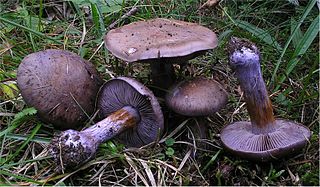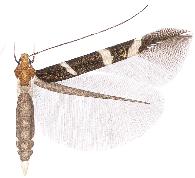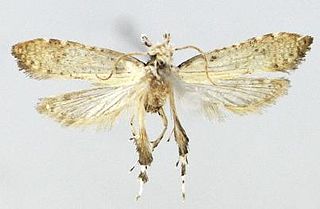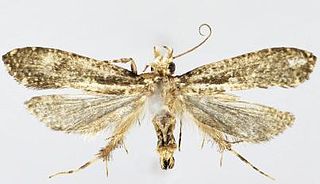
Tinea pellionella, the case-bearing clothes moth, is a species of tineoid moth in the family Tineidae, the fungus moths. This species has a cosmopolitan distribution, occurring nearly worldwide.

Psilocybe cyanofibrillosa, also known as rhododendron psilocybe and blue-haired psilocybe, is a psilocybin mushroom of the family Hymenogastraceae having psilocybin and psilocin as main active compounds. First documented in 1980 in the Pacific Northwest, it is relatively uncommon and can be distinguished from other closely related species by its smaller spores and forking cheilocystidia. Psilocybe cyanescens also has forking cheilocystidia, but less often than Psilocybe cyanofibrillosa. Psilocybe cyanofibrillosa is also distinguished from Psilocybe cyanescens by an absence of pleurocystidia. The name of this species refers to the fibrils on the Stipe (mycology) that turn bluish in age, or when handled.

Harpa doris, common name the rose harp, is a species of sea snail, a marine gastropod mollusk in the family Harpidae, the harp snails.
Tinissa cinerascens is a moth of the family Tineidae. It is found in New Guinea and surrounding islands and from the coasts of Queensland, Australia.
Tinissa rigida is a moth of the family Tineidae. It is found from Kai Island to New Guinea and has also been recorded from Kuranda, Queensland, Australia.

Thaxterogaster purpurascens is a species of mushroom producing fungus in the family Cortinariaceae. It is commonly known as the bruising webcap.

Mycena mustea is a species of mushroom in the family Mycenaceae. First described as a new species in 2007, the fungus is known only from Kanagawa, Japan, where it grows on dead fallen twigs in lowland forests. The mushroom's dull violet to grayish-violet cap, initially covered with a fine whitish powder, becomes smooth as it matures, and eventually reaches a diameter of up to 10 mm (0.39 in). The stem is slender, up to 90 mm (3.5 in) long, and is covered with stiff white hairs at the base. Underneath the cap are distantly spaced pale brownish gills that are narrowly attached to the stem. Microscopic characteristics of the mushroom include the weakly amyloid spores, the club-shaped cheilocystidia featuring one or more short knob-like protuberances, the absence of pleurocystidia, the diverticulate cap cuticle hyphae, and the absence of clamp connections.

Cosmopterix irrubricata is a moth of the family Cosmopterigidae. It is known from Jamaica and Veracruz, Mexico.

Cosmopterix trifasciella is a moth of the family Cosmopterigidae. It is known from Ecuador.

Tinissa is a genus of the fungus moth family (Tineidae). Therein, it belongs to the subfamily Scardiinae.

Tinissa indica is a moth of the family Tineidae. It is found in China, Taiwan, India, Sikkim and Bhutan.

Tinissa insularia is a moth of the family Tineidae. It is found in China (Yunnan), Malaysia, Borneo, Indonesia, the Philippines, New Guinea and the Solomon Islands.

Tinissa apicimaculata is a moth of the family Tineidae. It is found in Guangxi, China.

Tinissa conchata is a moth of the family Tineidae. It is found in China.

Tinissa connata is a moth of the family Tineidae. It is found in China.

Tinissa leguminella is a moth of the family Tineidae. It is found in Yunnan, China.
Tinissa polysema is a moth of the family Tineidae. It was described by Zagulajev in 1972. It is found on Java.

Thisizima fasciaria is a moth of the family Tineidae. It is found in China.

Thisizima subceratella is a moth of the family Tineidae. It is found in China.

Astroloba spirella is a small succulent plant of the genus Astroloba, restricted to an area of the western section of the Little Karoo, South Africa.














